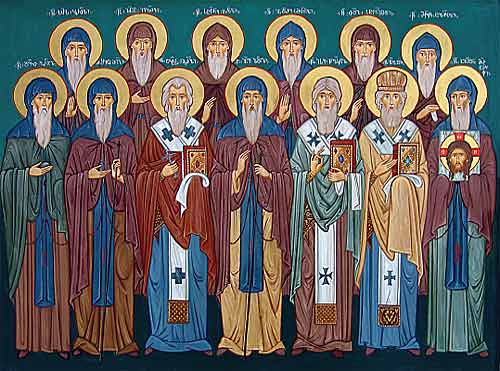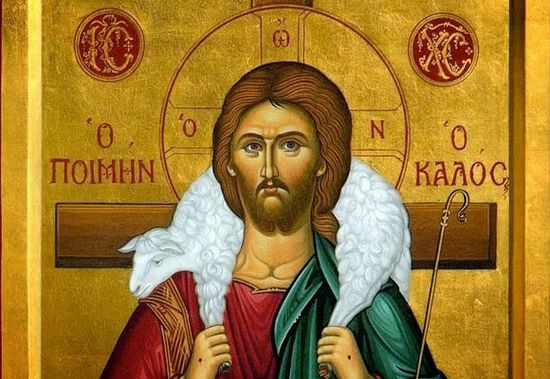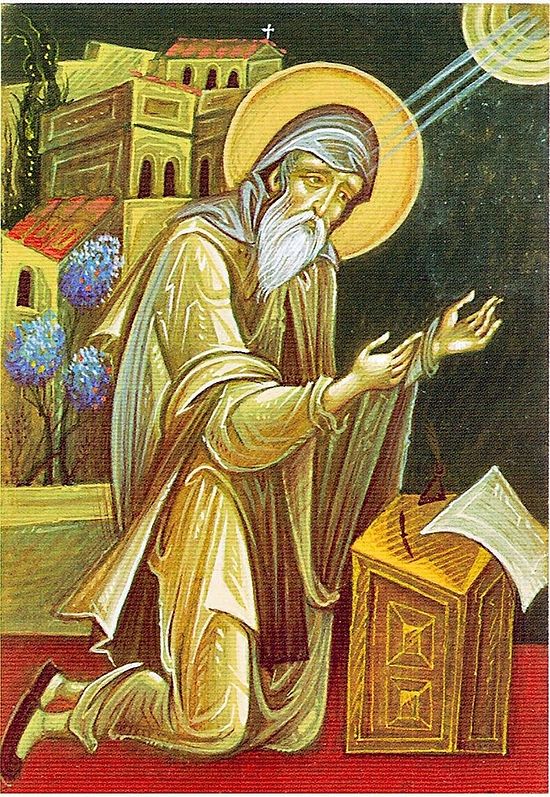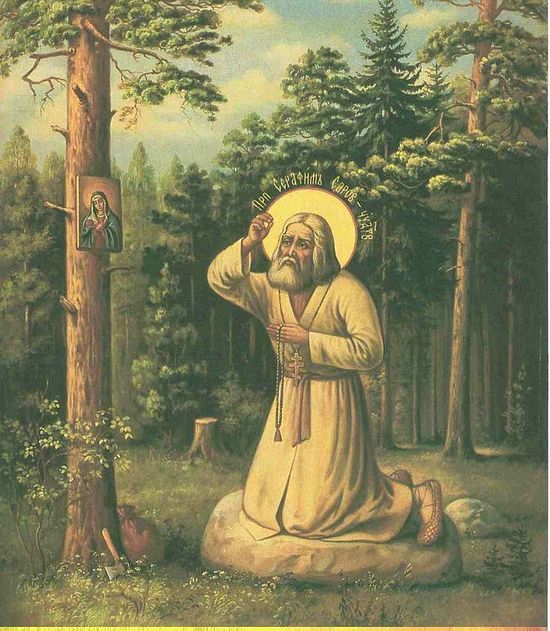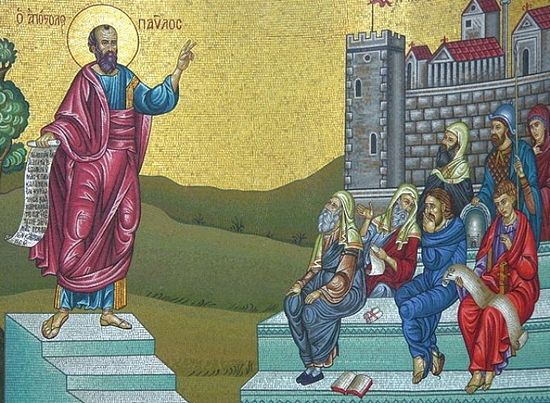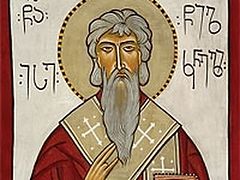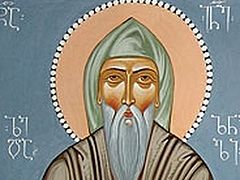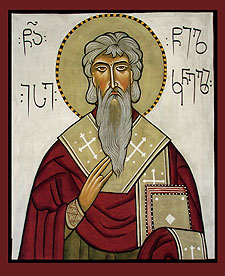
Today the Church remembers the holy bishop St. Jesse of Tsilkani in Georgia. It seems generally that many Orthodox Christians outside of Georgia are not very aware of the Georgian Church and its culture and saints. The Georgians have very beautiful chant and iconography and a deep spirituality which is evident in their many saints. Since most of us are probably unaware of him, I would like to say a little about St. Jesse today.
St. Jesse is one of the twelve Syrian disciples of St. John of Zedazeni who are remembered as the founding fathers of Georgian monasticism. After many years of living as a hermit, the Theotokos appeared to St. John and commanded him to take twelve disciples to Georgia to strengthen the souls of the people. St. Jesse and the rest were greeted by king Parsman and Catholicos Evlavios who then blessed them to move to Zedazeni Mountain and take up the ascetic life where a pagan temple once stood. Their spiritual struggles brought many to the mountain which was quickly transformed into a home for hermits. The Theotokos again appeared to St. John and instructed him to send his disciples throughout Georgia to preach the word of God.
St. Jesse was consecrated bishop of Tsilkani by Catholicos Evlavios. The holy bishop preached the good news of Christ and converted many unbelievers and found himself surrounded by many disciples. St. Jesse was also endowed with the ability to work miracles, and he healed the infirm, cleansed lepers, and cast out demons. Once, to test and strengthen the faith of his flock he went to the Ksani River, touched his staff to the water, and cried out “In the name of the Lord, I command you to follow me!” Immediately the river reversed its flow and followed the Saint’s footsteps all the way to Tsilkani Monastery. Having witnessed this miracle the people of his diocese glorified God and many more were converted to Christ.
St. Jesse was blessed to know the coming day of his repose. He gathered his disciples, blessed them, partook of the holy Eucharist and peacefully reposed in the Lord on December 2/15. His last words were those of the Lord Himself: “Lord, into Thy hands I commit my spirit!” St. Jesse is buried in the Tsilkani Church of the Most Holy Theotokos.
Brethren, St. Jesse exemplifies the good shepherd that we heard about in today’s Gospel reading. Of course the Good Shepherd is Christ Himself, but the Church has appointed this passage to be read for righteous hierarchs. St. Jesse was no mere hireling. His life was dedicated to asceticism and spreading the Gospel of Christ that souls might be saved. His sheep knew his voice and lovingly gathered around him in life and at the time of his death. In the Epistle St. Paul teaches us that our one true High Priest is also Christ Himself. Therefore, our earthly pastors must partake of the priesthood of Christ. Nowhere do we see St. Jesse seeking for his own glory. Nowhere do we see him seeking for earthly glory. He worked many miracles and converted many souls. These deeds were not accomplished by his own efforts but by allowing Christ to operate His priesthood through him. This is the essence of a good shepherd—one who loves his flock and serves them by the grace of God, and who imitates the sacrificial life and death of Christ.
St. Jesse’s disciples were inspired by his example and took up the Christian life with fervor. They imitated him because he imitated Christ, and we are all called to do the same thing. We are called to imitate those who imitate Christ. In his first letter to the Corinthians St. Paul says just that: Be ye followers of me, even as I also am of Christ. This applies not only to the saints, but even to our own clergy, our parents, our bosses, our friends, and anyone around us in whom we see the light of Christ. If we want to see Christ around us, we will. But do we imitate those who imitate Christ? Or do we want to be in charge of our own lives, and do whatever our reasoning tells us to do? Or do we look to the culture around us, which is unchristian at the least and anti-Christian at its worst, to get our values?
Every day the Church places a number of saints before us as lights on our path to Christ. But do we familiarize ourselves with the lives and works of these saints? Do we pay attention to their hymns during Church? Do we strive to know them through prayer? Do we gratefully receive their blessings? Or do we ignore them and judge them based on our own reasoning and desires? It is far too easy to find fault in the lives and writings of the saints, and to judge them as artifacts of a by-gone era based on our hyper-critical scholasticism. But the saints are alive and they are still speaking to us today. We can know them intimately through prayer. Everyone should try to build a relationship with their patron saint, their guardian angel, and certainly the Theotokos, and any other saint you may have a connection with. We imitate them because they imitate Christ.
As I said, this does not apply only to the saints of course. Each of us is called to have a spiritual father who cares for our soul. St. Paul teaches us many times to be obedient to those who have both earthly and spiritual authority over us. Obedience is blessed, and according to St. Silouan it is even a sacrament. By being obedient we learn to deny our own will which allows us to discern and do God’s will. St. Jesse commanded the river to follow him and it obeyed. Even nature responds to the man of God—how much more should we? And St. Jesse led the river to the monastery where life is dedicated to continual prayer. If we follow our spiritual fathers in obedience we will be led to a life of prayer and service to God. We imitate, and obey, those who imitate Christ.
Christ calls us to pick up our crosses daily, St. John the Forerunner teaches us that we must decrease and Christ must increase, and St. Paul emphasizes that he is not ashamed of the Gospel of Christ. If we also are not ashamed of the Gospel of Christ then we have much we can learn from the saints who have gone before us, who carried their crosses, and decreased that Christ might increase. As Orthodox Christians we have the blessing of prayerfully approaching Christ in humility and giving our whole lives over to Him to experience the fullness of joy, peace and life. But this should not be attempted alone. We have united ourselves to the Body of Christ, and we are in this together, with those who are here today and all those who have gone before, who are also here with us today. That is what our icons tell us—that the high-calling in Christ is possible to achieve in this lifetime, and those who have found rest in Christ are present with us in the communion of His Body. Their icons, their hymns, and their writings lift up our hearts and minds to Christ Who is the source of all joy, peace, and life. Imitate those who imitate Christ.
God has blessed the world with countless saints who light the path to Christ for us and demonstrate that theosis, the search for perfection in Christ, is indeed a possibility. By becoming familiar with their lives we learn what it means to seek this perfection in Christ and how to orient our lives. From the saints we learn what it means to love, to be patient, to be humble, to fast, to pray, and so on, and this is why we are called to imitate them. Fr. Zakaria, who gathered the lives of the Georgian saints such as St. Jesse, says “we are called to know them, to become familiar with their lives and their woks, and to reverently honor their memories.”
When we familiarize ourselves with the saints we are actually familiarizing ourselves with Christ. It is His light that we see in every halo in the icons. It is His mind that is expressed through the words and pens of the saints. The saints are those who have beheld the glorified Christ. This vision is at the very heart of our theology, and so the saint who has received that vision is also at the very heart of our theology, and our Orthodox life. And the saints are alive in Christ, in communion with us. St. Seraphim of Sarov had a special relationship with the Theotokos, as do the monks of Mt. Athos, and when studying the book of Genesis, Fr. Seraphim Rose became especially close to St. Basil who wrote his own book on Genesis, and this is possible for every one of us. Sometimes words and actions of the saints will not make sense to us and that is ok, that is to be expected. They are at a spiritual level above most of us. But through prayer and repentance we can internalize their examples though we may not intellectually grasp it all the time, and we can step closer and closer to their level—closer to Christ.
To imitate the saints is to recognize that we do not hold the answers to life’s problems and questions. It is a humbling thing. Only Christ has the answers. In fact, Christ is the answer, and the saints tell us this. Christ humbled Himself and accepted the cup of His Father and His Cross. He did this purely out of love for us. The saints humbled themselves and accepted their own crosses, and they did this purely out of love for Christ. How much do we love Christ? We too can humble ourselves before those in authority over us, and in fact before everyone we come in contact with, and accept our own cross, thereby imitating Christ and those who have imitated Him. To be in obedience is the safest spiritual place to be—obedience to the example of the saints, obedience to our spiritual father, obedience to the Church—and this all means obedience to Christ. Obedience is not slavery, obedience to Christ is freedom.
St. Jesse’s tropar says “Thou didst shine forth brilliantly as a radiant star and enlighten the hearts of the faithful with thy divine preaching. O Holy Hierarch Jesse, pray to Christ God to forgive the sins of those who glorify thy holy memory!” These are powerful words! He shone forth as a radiant star, and enlightened hearts. We have access in the Church to everything that St. Jesse had access to—the prayers, the services, the sacraments. If we imitate those who imitate Christ we can shine as radiant stars. St. Jesse had many of the qualities we have talked about. He was obedient to the Theotokos and his spiritual father and left his homeland, just like Abraham. We might be called to step out like this as well. Perhaps literally as a missionary or even right here in our own towns, just to step outside of our comfort zones. There is a prison, hospice and mission right in our area. It may not be comfortable, but Christ says if we visit them we have visited Him. St. Jesse worked miracles of healing. We may not be able to physically heal someone, but when we visit the less fortunate we bring them comfort. We offer them emotional and spiritual healing. When we pray for someone we offer them healing. When we turn to Christ to purify ourselves, our good example brings spiritual healing to others. St. Jesse lived a life of prayer and fasting. God is always listening when we speak to Him, and more importantly He speaks to us, and we can learn to listen. The prayers of the services and our private prayers are incredibly important for bringing us peace and holiness. And we don’t really enjoy fasting, right? But fasting can be our little offering to God—our willingness to give up something in order to give more to God. We must decrease, Christ must increase. St. Jesse was a great preacher and enflamed the hearts of those who heard him. Some of us may be called to literally preach, but every one of us can proclaim the Gospel through our words and deeds, through our entire lives. In our everyday lives, if we imitate those who imitate Christ then others will be drawn to Christ. Above all, St. Jesse loved Christ. Above all we can love Christ. Let us imitate St. Jesse.
In the Orthodox Church we are blessed with 2,000 years of consistent teaching on the spiritual life and what it means to grow in communion with Christ, and the hosts of saints demonstrate to us that theosis is attainable. Therefore take heart! Christ has overcome the world and grants us His grace to turn from sin and death and receive His life. The saints are our guides in this life because they gave their entire lives to Christ. St. Jesse of Tsilkani left his homeland to evangelize the people of Georgia and gave his life in asceticism to Christ and the people of his diocese. His selfless giving is an example for us all to follow in our own situations. St. Jesse gave his life to Christ. Through his prayers and those of all the saints we too can follow Christ, even to our last breath, and say with St. Jesse and our Lord: “Lord, into Thy hands I commit my spirit!”

